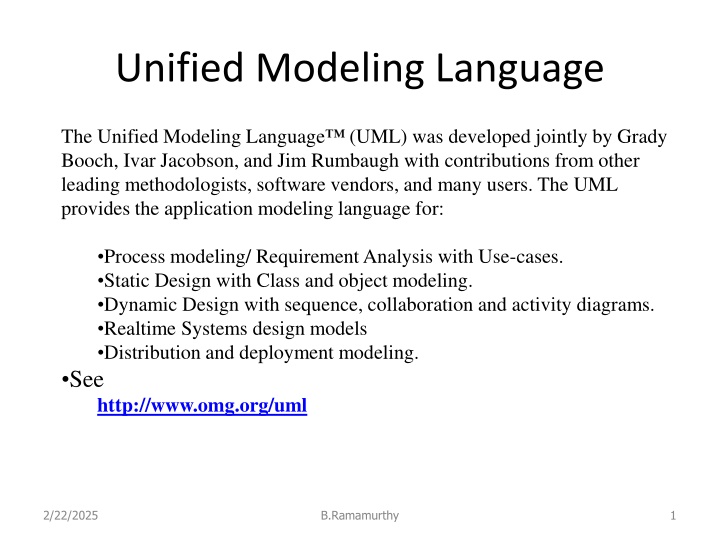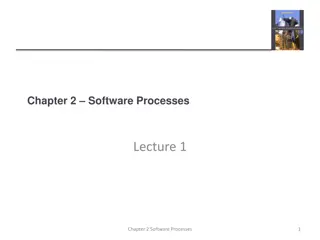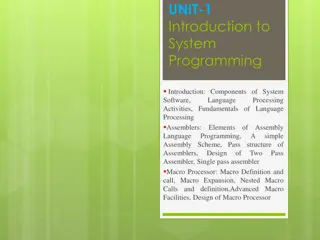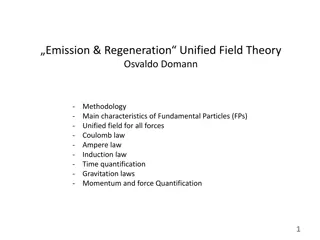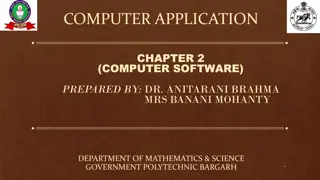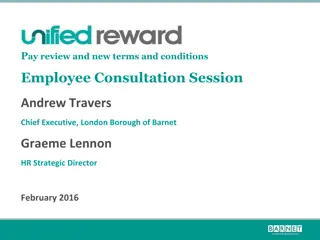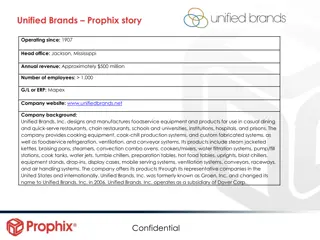Unified Modeling Language - Application Modeling for Software Development
Unified Modeling Language (UML) is a powerful tool developed by Grady Booch, Ivar Jacobson, and Jim Rumbaugh for modeling various aspects of software development. It encompasses phases like requirement analysis, object-oriented design, system development, and testing. Use-case modeling and components of a use-case model play a crucial role in defining system boundaries and interactions. Actors, system scope, and stimulus in use-case diagrams are essential for understanding system functionalities. With a mix of visual and text representations, UML aids in creating detailed specifications for coding and implementation.
Uploaded on Feb 22, 2025 | 0 Views
Download Presentation

Please find below an Image/Link to download the presentation.
The content on the website is provided AS IS for your information and personal use only. It may not be sold, licensed, or shared on other websites without obtaining consent from the author.If you encounter any issues during the download, it is possible that the publisher has removed the file from their server.
You are allowed to download the files provided on this website for personal or commercial use, subject to the condition that they are used lawfully. All files are the property of their respective owners.
The content on the website is provided AS IS for your information and personal use only. It may not be sold, licensed, or shared on other websites without obtaining consent from the author.
E N D
Presentation Transcript
Unified Modeling Language The Unified Modeling Language Booch, Ivar Jacobson, and Jim Rumbaugh with contributions from other leading methodologists, software vendors, and many users. The UML provides the application modeling language for: (UML) was developed jointly by Grady Process modeling/ Requirement Analysis with Use-cases. Static Design with Class and object modeling. Dynamic Design with sequence, collaboration and activity diagrams. Realtime Systems design models Distribution and deployment modeling. See http://www.omg.org/uml 2/22/2025 B.Ramamurthy 1
Phases of System Development Requirement Analysis The functionality users require from the system Use-case model OO Analysis Discovering classes and relationships Class diagram OO Design Result of Analysis expanded into technical solution Sequence diagram, state diagram, etc. Results in detailed specs for the coding phase Implementation (Programming/coding) Models are converted into code Testing Unit tests, integration tests, system tests and acceptance tests. 2/22/2025 B.Ramamurthy 2
Use-Case Modeling In use-case modeling, the system is looked upon as a black box whose boundaries are defined by its functionality to external stimuli. The actual description of the use-case is usually given in plain text. A popular notation promoted by UML is the stick figure notation. We will look into the details of text representation later. Both visual and text representation are needed for a complete view. A use-case model represents the use-case view of the system. A use-case view of a system may consist of many Use-case diagrams. An use-case diagram shows (the system), the actors, the use-cases and the relationship among them. 2/22/2025 B.Ramamurthy 3
Components of Use-case Model The components of a Use-case model are: System Modeled Actors Use-cases Stimulus name System Name Use-case 2/22/2025 B.Ramamurthy 4
System As a part of the use-case modeling, the boundaries of the system are developed. System in the use-case diagram is a box with the name appearing on the top. Define the scope of the system that you are going to design. For example, in the drone project, you are not learning to drive but programming the drone to do something. Drone API programming 2/22/2025 B.Ramamurthy 5
Actors An actor is something or someone that interacts with the system. Actor communicates with the system by sending and receiving messages. An actor provides the stimulus to activate an Use- case. Message sent by an actor may result in more messages to actors and to Use-cases. Actors can be ranked: primary and secondary; passive and active. Actor is a role not an individual instance. 2/22/2025 B.Ramamurthy 6
Finding Actors The actors of a system can be identified by answering a number of questions: Who will use the functionality of the system? Who will maintain the system? What devices does the system need to handle? What other system does this system need to interact? Who or what has interest in the results of this system? 2/22/2025 B.Ramamurthy 7
Use-cases A Use-case in UML is defined as a set of sequences of actions a system performs that yield an observable result of value to a particular actor. Actions can involve communicating with number of actors as well as performing calculations and work inside the system. A Use-case is always initiated by an actor. provides a value to an actor. must always be connected to at least one actor. must be a complete description. 2/22/2025 B.Ramamurthy 8
Finding Use-cases For each actor ask these questions: Which functions does the actor require from the system? What does the actor need to do? Could the actor s work be simplified or made efficient by new functions in the system? What events are needed in the system? What are the problems with the existing systems? What are the inputs and outputs of the system? 2/22/2025 B.Ramamurthy 9
Describing Use-cases Use-case Name: Use-case Number: system#.diagram#.Use-case# Authors: Event(Stimulus): Actors: Overview: brief statement Related Use-cases: Typical Process description: Algorithm Exceptions and how to handle exceptions: 2/22/2025 B.Ramamurthy 10
Example Number: A.132.4 Name: Buy book online Author: B.Ramamurthy Event: Customer request one or more books System: Amazon.com Overview: Captures the process of purchasing one or more books and the transactions associated with it. Related Use-case: A.132.5, A.132.8 Typical Process Description with exceptions handled. NOTE : All these can be in a tabular form, say, in an Excel worksheet for example. 2/22/2025 B.Ramamurthy 11
Realizing Use-cases Validation is done up front. As soon as the model is ready it has to be presented and discussed with the customers. Use-cases are implementation independent descriptions of the functionality of the system. Use-case can be realized in the next stages of software development using, say, a class diagram. 2/22/2025 B.Ramamurthy 12
Interaction between user and Use-case Insert coins Count coins Show/see drinks Show drink N/A Choose drink Deliver/pickup drink 2/22/2025 B.Ramamurthy 13
Use Case Diagram Insert coins <<uses>> Count coins Show/see drinks <<uses> Show drink N/A Choose drink Deliver/pickup drink 2/22/2025 B.Ramamurthy 14
Case Studies Ticket counter for basketball game TIVO: Video recorder/controller Weather Station. ATM Machine: Description given as data dictionary. 4-cycle lawnmower engine Burger queen fast food restaurant s hand-held order device 2/22/2025 B.Ramamurthy 15
Use Case Example: Counseling Request Counseling Patient Provide Consent Real or Virtual Counselor Video conference Order Tests Authenticate View Results Referral Followup 2/22/2025 B.Ramamurthy 16
Example Carry out a use-case analysis of the operations performed by a parking ticket vending machine. Consider end-user (motorist), maintenance technician, auditor, and coin (money) collector. Use tools such as draw.io or other UML tools. 2/22/2025 B.Ramamurthy 17
Summary : Use case model We studied the Use-case Model of Unified Modeling Language. Use-case model provides a formal mechanism for carrying out a requirement analysis with active participation from domain experts and users who may or may not be software savvy. Use-case model can be used not only for requirement analysis of software systems, hardware systems and hybrid (combination) systems. Now armed with these information, go ahead analyze your problem and obtain the use case diagram. 2/22/2025 B.Ramamurthy 18
